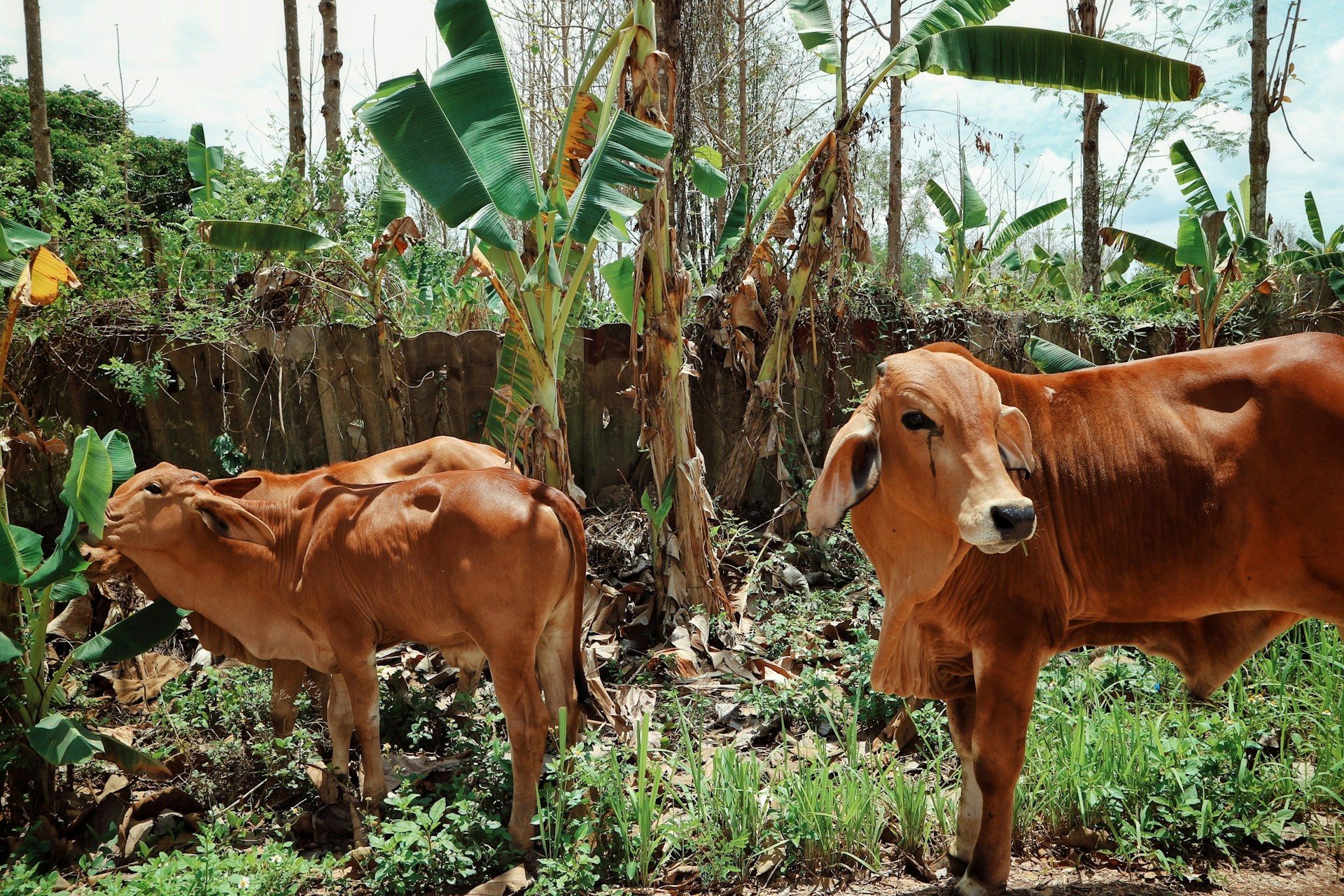Introduction
Brown cows have captured the curiosity of many, whether it’s due to their distinct coloration, unique characteristics, or their role in the dairy industry. This comprehensive guide will explore everything you need to know about brown cows, from their breeds and characteristics to their dietary needs and role in agriculture. By the end of this article, you’ll have a thorough understanding of these fascinating animals and why they are so important.
What Are Brown Cows?
Brown cows are cattle that have a brown-colored coat. The term “brown cow” is quite broad and can refer to several breeds of cows that have this coat color. Unlike specific breeds like Holstein, known for their black and white patterns, brown cows can belong to various breeds and have different shades of brown, ranging from light tan to dark chocolate.
Common Breeds of Brown Cows
- Jersey Cattle: Jerseys are perhaps the most famous brown cows. They are small dairy cows known for their rich, creamy milk with a high butterfat content. Jerseys usually have a light brown coat but can range from a greyish fawn to a deep chocolate hue.
- Brown Swiss: As the name suggests, Brown Swiss cattle are typically brown. They are one of the oldest dairy breeds and are renowned for their hardiness and adaptability to different climates. Their milk is prized for cheese-making due to its high protein content.
- Guernsey Cattle: Guernseys are another breed known for their brown and white coats. They produce milk with a golden color due to the high beta-carotene content, making their milk a favorite for those who prefer natural, nutrient-rich dairy products.
- Ayrshire: While traditionally red and white, some Ayrshire cows can have a brown tint to their coat, especially in areas with a mix of breeds. They are known for their vigorous health and strong, well-balanced udders.
- Devon Cattle: Also known as the Red Devon, these cows have a deep reddish-brown coat and are used both for milk and beef production. They are known for their docile nature and adaptability to various grazing conditions.
Characteristics of Brown Cows
Brown cows, depending on their breed, have various characteristics that set them apart from other cattle. Understanding these traits helps farmers and ranchers manage their herds more effectively.
Physical Characteristics
- Size and Build: Brown cows can range from the smaller Jerseys, weighing around 900 pounds, to the larger Brown Swiss, which can weigh up to 1,500 pounds. Most brown cows have a sturdy build, well-suited for both dairy and beef production.
- Coat and Coloration: The brown coat of these cows can vary significantly. For example, Jersey cows have a sleek, shiny coat that can range from light fawn to deep brown. In contrast, Brown Swiss have a denser, thicker coat, which helps them withstand colder climates.
- Temperament: Many brown cow breeds are known for their gentle and docile temperament. This makes them easier to handle compared to more temperamental breeds. For instance, Jerseys are known for being particularly friendly and curious, making them popular on dairy farms.
Milk Production
Brown cows are often favored in the dairy industry for their milk quality rather than quantity. Breeds like Jersey and Guernsey produce milk that is rich in butterfat and protein, essential for making high-quality dairy products such as cheese, butter, and ice cream. This high butterfat content also makes their milk creamier and sweeter compared to milk from other breeds like Holstein.
Adaptability
Brown cows are known for their adaptability to various environmental conditions. The Brown Swiss, for instance, is highly adaptable and can thrive in both hot and cold climates. This adaptability makes them a versatile choice for dairy farmers in different geographic locations.
The Role of Brown Cows in Agriculture
Brown cows play a significant role in agriculture, both in dairy and meat production. Understanding their role helps in appreciating their value to the farming community.
Dairy Industry
The dairy industry values brown cows, particularly the Jersey and Guernsey breeds, for their rich milk. The high butterfat content in their milk is ideal for producing premium dairy products, which are in high demand globally. Farmers who focus on quality over quantity often choose brown cows for their dairy herds.
Beef Production
While not as common, some brown cow breeds are also used in beef production. Breeds like the Devon are known for their flavorful meat and efficient grazing habits. They are often raised in pasture-based systems, which is a more sustainable form of farming compared to grain-fed beef.
Sustainability
Brown cows, especially those used in pasture-based dairy and beef systems, contribute to sustainable farming practices. They often require fewer resources than more intensive farming systems, reducing their environmental impact. Their adaptability to various climates also means they can be raised in a range of environments, from mountainous regions to flat pastures.
Dietary Needs of Brown Cows
Feeding brown cows requires understanding their dietary needs, which vary depending on their breed, age, and purpose (dairy vs. beef).
Forage-Based Diet
Most brown cows are raised on a forage-based diet, primarily consisting of grasses and legumes. This diet is ideal for ruminants like cows, as it allows them to digest fibrous plant materials effectively. Pasture-based feeding is common for dairy breeds like Jersey and Guernsey, whose milk production benefits from a natural, grass-fed diet.
Grain Supplementation
While forage is the main component of their diet, some brown cows, particularly those in dairy production, may receive grain supplements. Grain helps meet the higher energy demands of dairy cows, especially those producing large quantities of milk. However, excessive grain feeding can lead to health problems, so it’s essential to balance their diet carefully.
Mineral and Vitamin Supplements
To ensure brown cows remain healthy and productive, their diet often includes mineral and vitamin supplements. These supplements help prevent deficiencies and support overall health, particularly in dairy cows with high nutritional needs due to milk production.
Health and Maintenance of Brown Cows
Proper health care and maintenance are crucial for keeping brown cows healthy and productive. Understanding the common health issues and management practices can help farmers maintain a thriving herd.
Common Health Issues
- Mastitis: A common issue in dairy cows, mastitis is an inflammation of the udder, usually caused by bacterial infection. It can affect milk quality and quantity, making early detection and treatment essential.
- Bloat: This is a digestive disorder that occurs when cows are unable to expel gas from their stomach. It can be life-threatening if not treated promptly. Managing diet and ensuring cows have access to fresh water can help prevent bloat.
- Hoof Problems: Brown cows, like all cattle, can suffer from hoof issues such as foot rot or laminitis. Regular hoof trimming and maintaining clean, dry living conditions can prevent these problems.
- Nutritional Deficiencies: Without proper supplementation, brown cows can suffer from deficiencies in minerals like calcium, phosphorus, and magnesium, leading to issues like milk fever in dairy cows.
Management Practices
- Regular Health Checks: Routine health checks are vital for detecting early signs of illness or nutritional deficiencies. Regular veterinary visits ensure cows are healthy and can continue producing quality milk or meat.
- Proper Housing: Providing adequate shelter protects cows from extreme weather conditions and reduces stress, which can impact milk production and overall health.
- Clean Water Supply: Ensuring a clean and continuous water supply is essential for maintaining the health of brown cows. Hydration is crucial, especially for dairy cows producing milk.
- Grazing Management: Rotational grazing practices help maintain pasture quality and ensure cows have access to fresh grass, promoting better milk production and overall health.
Breeding and Genetics of Brown Cows
Breeding practices and genetics play a crucial role in the development of brown cow breeds. Understanding these aspects can help farmers improve their herds for specific traits, such as milk production, temperament, and adaptability.
Selective Breeding
Selective breeding involves choosing specific cows and bulls with desirable traits to produce offspring with those traits. In the case of brown cows, farmers may select for traits like high butterfat content in milk, docile temperament, or adaptability to different climates.
Crossbreeding
Crossbreeding is another common practice that involves breeding two different breeds to combine desirable traits. For instance, a farmer may cross a Jersey cow with a Holstein to improve milk yield while maintaining high butterfat content. Crossbreeding can also enhance genetic diversity, reducing the risk of inherited diseases.
Genetic Testing
With advances in genetic testing, farmers can now screen cows for specific genetic traits or potential health issues. This technology allows for more informed breeding decisions, ensuring healthier and more productive herds. Genetic testing can identify cows with the best potential for milk production, disease resistance, and overall health.
The Economics of Raising Brown Cows
Raising brown cows can be economically viable, but it requires understanding the costs and benefits associated with different breeds and production systems.
Initial Costs
The initial cost of purchasing brown cows varies depending on the breed, age, and quality of the animals. Jersey cows, for example, may cost more due to their high-quality milk, while breeds like Brown Swiss might have a lower initial cost but higher maintenance costs due to their size.
Maintenance Costs
Maintenance costs include feed, veterinary care, housing, and labor. Dairy cows typically have higher maintenance costs due to their dietary needs and the labor required for milking. However, the high-quality milk they produce can offset these costs if sold at a premium price.
Revenue Streams
Farmers raising brown cows have several revenue streams, including milk, meat, and breeding stock sales. Diversifying these streams can help mitigate risks and ensure a steady income. For instance, a dairy farmer might sell milk and surplus heifers, while a beef farmer might sell both meat and breeding bulls.
Market Demand
The demand for brown cow products, particularly high-butterfat milk, can affect profitability. Understanding market trends and consumer preferences can help farmers make informed decisions about which breeds to raise and what products to offer.
Environmental Impact of Brown Cows
Like all livestock, these cows have an environmental impact. Understanding these impacts can help farmers adopt more sustainable practices.
Greenhouse Gas Emissions
Cattle are significant producers of methane, a potent greenhouse gas. However, pasture-based systems, which are common for many brown cow breeds, can help sequester carbon in the soil, offsetting some of these emissions. Farmers can also implement practices like rotational grazing to reduce the environmental footprint of their herds.
Land Use
Raising these cows requires significant land, particularly for pasture-based systems. However, well-managed grazing can improve soil health and promote biodiversity. Farmers can also use integrated farming practices, combining livestock and crop production to maximize land use efficiency.
Water Use
Dairy and beef production require substantial water resources, not just for the cows themselves but also for growing their feed. Implementing water-saving practices, such as using efficient irrigation systems and maintaining clean water sources, can help reduce water use.
Conclusion
Brown cows are more than just their color; they are a diverse group of cattle with unique traits that make them valuable in various agricultural settings. From their high-quality milk production to their adaptability and gentle nature, it plays a significant role in both dairy and beef industries. Understanding their characteristics, needs, and economic potential can help farmers make informed decisions about raising these remarkable animals. Whether you’re a farmer considering adding it to your herd or simply interested in learning more about them, this guide provides a comprehensive overview of what makes it special.
FAQs
1. What are the common breeds of brown cows?
It can belong to several breeds, including Jersey, Brown Swiss, Guernsey, Ayrshire, and Devon. Each breed has its unique characteristics, milk production qualities, and adaptability to different environments.
2. Why are brown cows popular in the dairy industry?
It, particularly Jersey and Guernsey breeds, are popular in the dairy industry due to their milk’s high butterfat and protein content. This makes their milk ideal for producing premium dairy products such as cheese, butter, and ice cream.
3. What are the dietary needs of brown cows?
It typically thrive on a forage-based diet consisting of grasses and legumes. Some may receive grain supplements to meet higher energy demands, especially in dairy production. It’s also essential to provide mineral and vitamin supplements to ensure overall health.
4. How do brown cows contribute to sustainable farming?
It, especially those raised in pasture-based systems, contribute to sustainable farming by requiring fewer resources and reducing their environmental impact. Practices like rotational grazing can help maintain pasture quality and promote soil health, making farming more sustainable.
5. What are the common health issues in brown cows?
Common health issues in it include mastitis, bloat, hoof problems, and nutritional deficiencies. Regular health checks, proper housing, clean water supply, and good grazing management practices can help prevent these issues and maintain healthy herds.




